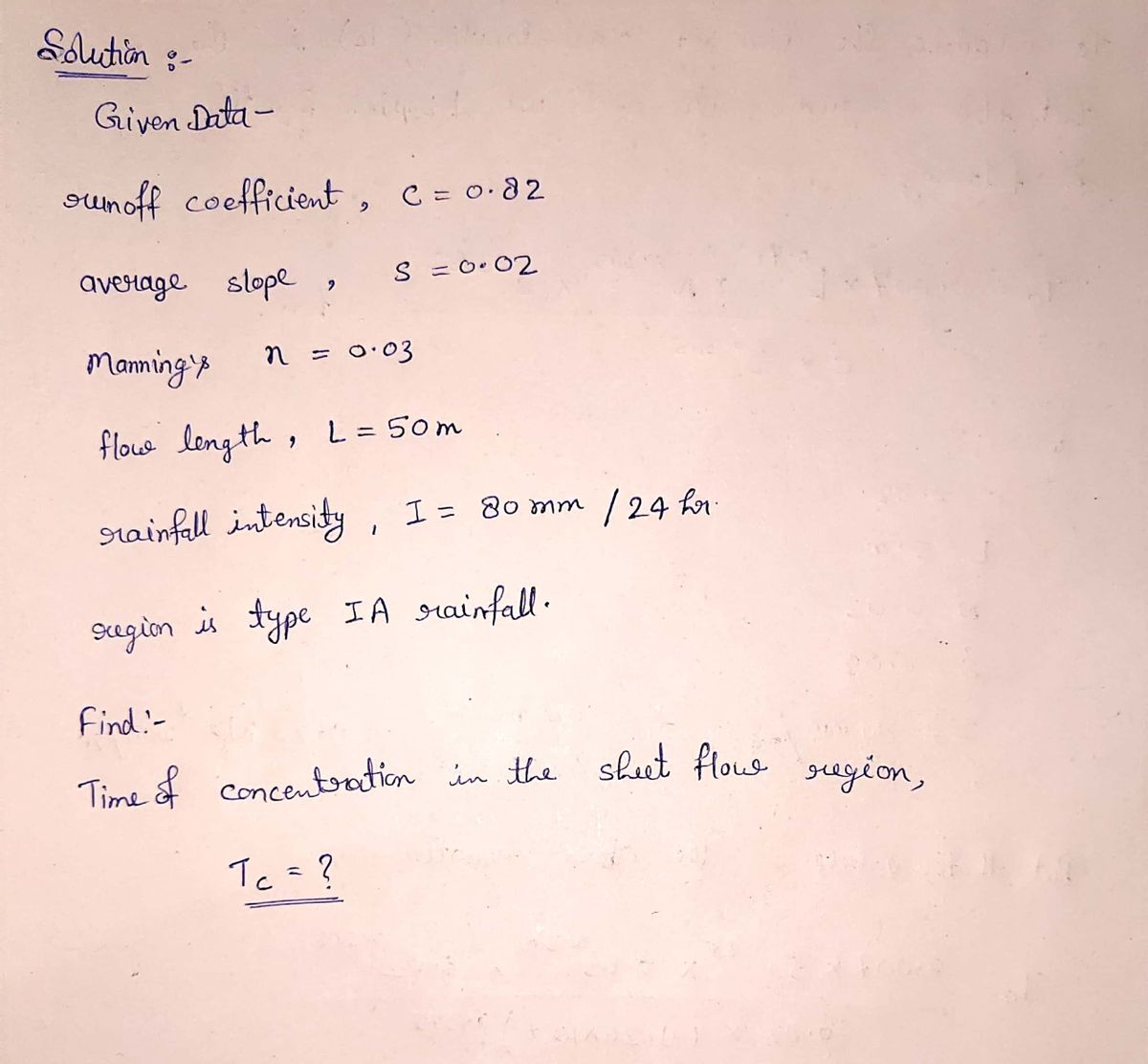Consider a catchment that has a runoff coefficient of 0.82, an average slope of 0.02, a Manning's n of 0.03, and a flow length of 50 m. If the catchment is located in a region with Type IA rainfall, and the 2-yr 24-h rainfall is 80 mm, estimate the time of concentration in the sheet-flow regime.
Consider a catchment that has a runoff coefficient of 0.82, an average slope of 0.02, a Manning's n of 0.03, and a flow length of 50 m. If the catchment is located in a region with Type IA rainfall, and the 2-yr 24-h rainfall is 80 mm, estimate the time of concentration in the sheet-flow regime.
Chapter2: Loads On Structures
Section: Chapter Questions
Problem 1P
Related questions
Question

Transcribed Image Text:**Problem Statement:**
Consider a catchment that has a runoff coefficient of 0.82, an average slope of 0.02, a Manning’s n of 0.03, and a flow length of 50 m. If the catchment is located in a region with Type IA rainfall, and the 2-yr 24-h rainfall is 80 mm, estimate the time of concentration in the sheet-flow regime.
**Explanation for Educational Context:**
- **Runoff Coefficient (0.82):** This indicates a high potential for surface runoff. A higher coefficient suggests that a large portion of rainfall will become surface runoff.
- **Average Slope (0.02):** The gentle slope affects how quickly water will move across the surface.
- **Manning’s n (0.03):** This roughness coefficient represents the resistance to flow. A higher Manning’s n implies more resistance and slower flow.
- **Flow Length (50 m):** The distance water needs to travel, affecting the overall time of concentration.
- **Type IA Rainfall:** Represents a specific pattern or intensity distribution of rainfall used for hydrological calculations.
- **2-yr 24-h Rainfall (80 mm):** Refers to the expected rainfall total over a 24-hour period, once every two years; important for designing drainage systems.
The task is to estimate the "time of concentration," which is the time it takes for water to travel from the most distant point of the catchment to its outlet. This is crucial for hydraulic and hydrologic design, as it influences the peak discharge rates and the sizing of drainage infrastructure.
Expert Solution
Step 1: Given data

Step by step
Solved in 3 steps with 2 images

Knowledge Booster
Learn more about
Need a deep-dive on the concept behind this application? Look no further. Learn more about this topic, civil-engineering and related others by exploring similar questions and additional content below.Recommended textbooks for you


Structural Analysis (10th Edition)
Civil Engineering
ISBN:
9780134610672
Author:
Russell C. Hibbeler
Publisher:
PEARSON

Principles of Foundation Engineering (MindTap Cou…
Civil Engineering
ISBN:
9781337705028
Author:
Braja M. Das, Nagaratnam Sivakugan
Publisher:
Cengage Learning


Structural Analysis (10th Edition)
Civil Engineering
ISBN:
9780134610672
Author:
Russell C. Hibbeler
Publisher:
PEARSON

Principles of Foundation Engineering (MindTap Cou…
Civil Engineering
ISBN:
9781337705028
Author:
Braja M. Das, Nagaratnam Sivakugan
Publisher:
Cengage Learning

Fundamentals of Structural Analysis
Civil Engineering
ISBN:
9780073398006
Author:
Kenneth M. Leet Emeritus, Chia-Ming Uang, Joel Lanning
Publisher:
McGraw-Hill Education


Traffic and Highway Engineering
Civil Engineering
ISBN:
9781305156241
Author:
Garber, Nicholas J.
Publisher:
Cengage Learning